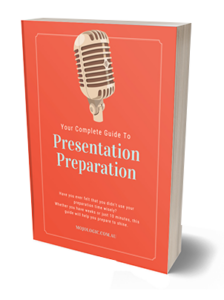Fillers — What are they?
The most common filler sounds are: ‘um‘, ‘ah‘, ‘oh‘, ‘huh‘, ‘mmmm‘…
Then we advance to filler words, including: ‘yes‘, ‘so‘, ‘basically‘, ‘absolutely‘, ‘obviously‘, ‘literally‘…
And, for the experienced players an array of filler phrases: ‘you know‘, ‘moving on‘, ‘I think that’, ‘I guess‘, ‘I’m just saying‘, ‘to be honest‘.
Why do we use them?
They are natural
Your filler words have been with you for a long time. They have become a part of your personal communication pattern, like a signature. On stage or off – presenting, speaking or chatting, your filler words come out – unplanned and unrehearsed.
They are comfortable
There is no doubt that speaking in front of an audience can be daunting. Nerves are unavoidable. When we are on the spot, trying to remember what to say next, we naturally bridge the gap with comfortable, familiar verbal crutches.
They connect thoughts (for you)
As you move from one idea to the next or shift from explaining a concept to providing an example, we search for a link. This link finds its manifestation when it comes out of your mouth as a filler sound, word or phrase. The fillers are the mental connective tissue you unconsciously add to your presentation.
Why does it matter?
At best, filler words clutter your presentation with verbal static.
At worst, they distract from the message you intend to deliver.
In either case, they add nothing. It is worth the effort to become aware of your filler sounds, words or phrases, assess the impact and clean up your language.
This is about a general de-cluttering rather than eradication of all filler words. After all, they are natural, so a few will go unnoticed.
What can you do about it?
1. Raise your awareness
If you don’t know, you can’t make a change. You have a few options here.
Level 1 is to enlist the help of a friend. Ask them to identify your filler words you use and keep a tally of how many times you say them.
Level 2 is to record your presentation. Play the recording back and listen for your fillers.
Level 3 is to video your presentation. Awkward as it might be, watching and listening to yourself will provide you with the most powerful feedback.
2. Assess your fillers
- Notice the circumstances in which your filler words naturally arise. Are you shuffling your notes, changing slides or presenting some other kind of visual support? Identify your trigger.
- What is the impact? um, er and ah, when used repeatedly can distract and rob you of some credibility. When used occasionally they hardly matter. Take note of anything that distracts.
3. Get comfortable with silence
If Newton devised a 6th law it would be that human beings abhor silence.
It seems this is most acutely felt by the person standing at the microphone. We feel we must fill all the empty space with words or at least sounds.
In reality, the noise is not necessary. A little bit of silence in the place of your transitions will allow your audience to catch up and assimilate the information you have provided.
Embrace the pause.
4. Slow Down
When the nerves are jumping our adrenaline kicks in. Most people speak far more quickly when on stage than they naturally would.
As a rule of thumb – try speaking at half pace.
5. Rehearse
The more comfortable you are with your presentation (the content, order, visuals and timing) the more smooth the delivery will be. It is true that you may have moments of brilliance on stage – when you shoot from the hip and deliver a stellar performance. But preparation is about ensuring this happens more often and on purpose.
The best public speakers practice – to a mirror, to camera, to colleagues, to the cat…
The good news?
Cleaning up your use of filler words is relatively easy to do. After all, once you know what to do you can choose to change the behaviour. Select one thing to change in your next presentation.
Good luck!


